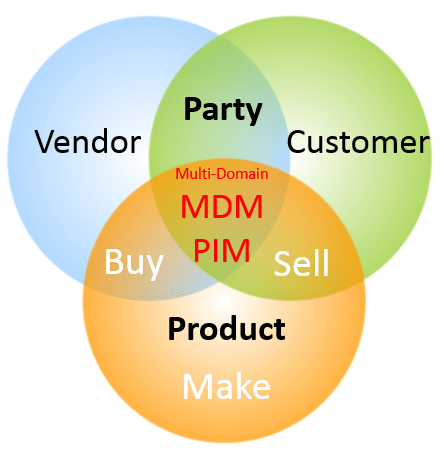As reported in the post Gravitational Waves in the MDM World there is a tendency in the MDM (Master Data Management) market and in MDM programmes around to encompass both the party domain and the product domain.
The party domain is still often treated as two separate domains, being the vendor (or supplier) domain and the customer domain. However, there are good reasons for seeing the intersection of vendor master data and customer master data as party master data. These reasons are most obvious when we look at the B2B (business-to-business) part of our master data, because:
- You will always find that many real world entities have a vendor role as well as a customer role to you
- The basic master data has the same structure (identification, names, addresses and contact data
- You need the same third party validation and enrichment capabilities for customer roles and vendor roles.
These reasons also applies to other party roles as examined in the post 360° Business Partner View.
When we look at the product domain we also have a huge need to connect the buy side and the sell side of our business – and the make side for that matter where we have in-house production.

Multi-Domain MDM has a side effect, so to speak, about bringing the sell-side together with the buy- and make-side. PIM (Product Information Management), which we often see as the ancestor to product MDM, has the same challenge. Here we also need to bring the sell-side and and the buy-side together – on three frontiers:
- Bringing the internal buy-side and sell-side together not at least when looking at product hierarchies
- Bringing our buy-side in synchronization with our upstream vendors/suppliers sell-side when it comes to product data
- Bringing our sell-side in synchronization with our downstream customers buy-side when it comes to product data
Henrik
Is it possible to extend this MDM concept to *all* of the data values in an organization? It seems logical to try, because what I see when I look at your domain diagram is three Action values (Buy, Sell, Make) two Function values (Vendor and Customer), and two Concept values (Product and Party). These last two in turn intersect with entities in the form of Assets and Organizations respectively
All you are missing is Location master data, and Temporal master data and you have the whole set.
Hi John. I agree. Indeed the location domain and the asset domain are part of the master data story too. Location data are something that can be shared easily among everyone and assets can be shared between business partners.
So… if you think of facets instead of domain it turns out that managing terminology (words, acronyms, names, abbreviations, aliases, etc.) in six major areas means you can introduce a universal (domain-independent) method for managing *all* (meta-, reference-. master-structured and unstructured data.
We should team up!